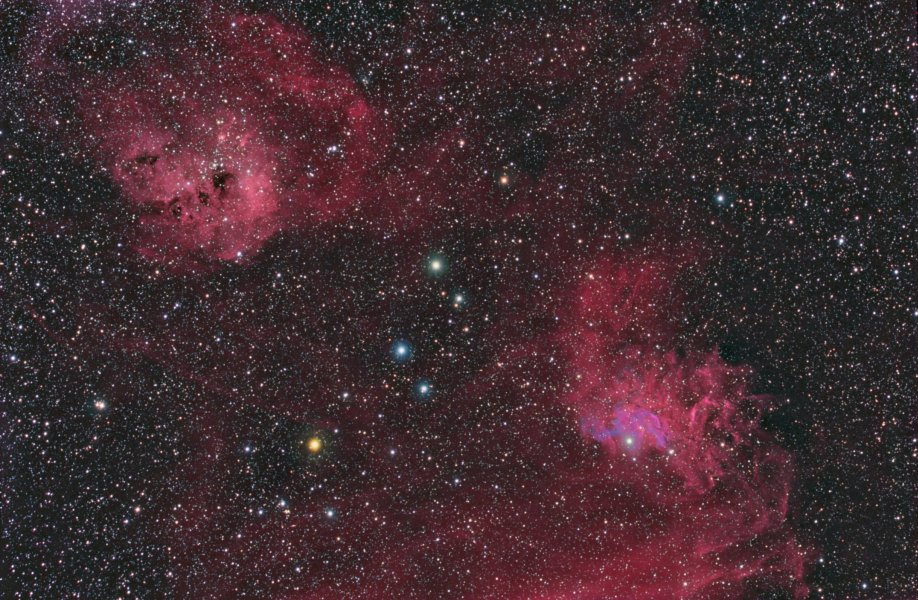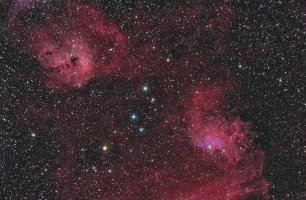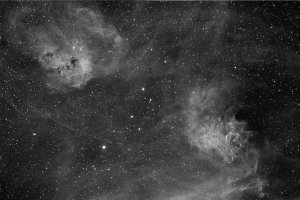IC 405 and IC 410 |
||
 |
||
|
||
| IC 405 (the nebula to the lower right in this
image) is also known as the Flaming Star Nebula. It is both an
emission (glow from ionized gas) and reflection (light reflected
from dust) nebula. What makes this nebula different from most
other emission nebulae is that the primary source of its glow,
AE Aurigae, was not born within this nebula. In fact, the star
has been traced back to having come from the Trapezium region of
the Orion Nebula! Auriga the Charioteer is a constellation in the northern sky, following in the heels of the hero Perseus in the sky. Orion is way south of Auriga from our perspective. AE Aurigae has travelled at least a quarter of the way across our sky from our perspective! IC 410 is a more "traditional" emission nebula, i.e., it is a stellar nursery. It is about 100 light-years across and is glowing from the radiation of stars in the open cluster NGC 1893 embedded within. A couple of notable features are the "Tadpoles" (visible above the largest dark region within IC 410), which are estimated to be ten light-years long and possible sites of ongoing star formation. IC 405 is listed as being 1500 light-years away, while IC 410 is 12,000 light-years away. This means that the two objects are not related at all; their apparent proximity is simply a chance juxtaposition of two very objects! Also, though they appear in the image to be similarly sized, IC 410 at 100 light-years is far larger than IC 405 at 5 light-years. Oddly enough, while a search on the web lists the objects as being disparately far away, I have also come across some writings that state that the two objects are part of the same large nebula complex! |
||
| Constellation: Auriga | ||
| When Visible: November - April | ||
| Distance: 1,500 light-years (IC 405), 12,000 light-years (IC 410) | ||
| Date: November 2006 | ||
| Location: West Chester, Ohio | ||
| Exposure Details:
H-alpha: 6 x 30 Minutes Binned 1x1 R: 21 x 5 Minutes binned 1x1 G: 21 x 5 Minutes binned 1x1 B: 21 x 5 Minutes binned 1x1 |
||
| Equipment Used: Takahashi FSQ-106N on a Takahashi EM200 Temma-PC mount. SBIG STL-6303 camera with 5-position filter wheel and Astrodon narrowband filters. Externally guided with an SBIG Remote Guide Head on a Borg 76ED refractor. | ||
| Acquisition Software : MaximDL, TheSky6, CCDAutopilot | ||
| Processing Software: MaximDL, Photoshop CS, IrFanView | ||
| Earlier on in my imaging experience, I was initially wondering if I had the skills at all for narrowband imaging. These two objects in particular were proved very challenging for me to bring out from the background at all as these images of IC 405 and IC 410 from 2005 show. Both were taken with a Borg 76ED, an ST-8XE camera and a Custom-Scientific 4.5 nm Hydrogen-Alpha filter. Despite exposure lengths of 30 minutes, IC410 was barely coming out of the sky with this setup. Switching to the STL-6303, Astrodon 6nm H-alpha filter and Takahashi FSQ-106, narrowband data acquisition suddenly became almost too easy. My best guess as to the disparity (with input from imaging guru Adam Block) is that the ST-8XE camera itself may have had a chip that was not that sensitive to H-alpha wavelengths. |


